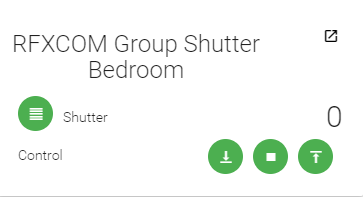Robert, I do have a question though: if I have created item descriptions for my shutters in a specific items file, see below:
Group:Rollershutter:OR(UP, DOWN) gShutters "Alle Rollläden [%d]" <rollershutter>
Group:Rollershutter:OR(UP, DOWN) gShutters_EG "EG Rollläden [%d]" <rollershutter> (gShutters)
Group:Rollershutter:OR(UP, DOWN) gShutters_OG "OG Rollläden [%d]" <rollershutter> (gShutters)
Group:Rollershutter:OR(UP, DOWN) gShutters_SOUTH "Südl. Rollläden [%d]" <rollershutter> (gShutters)
Group:Rollershutter:OR(UP, DOWN) gShutters_WEST "West. Rollläden [%d]" <rollershutter> (gShutters)
Group:Rollershutter:OR (UP, DOWN) gShutters_Office "Büro Rollläden [%d]" <rollershutter> (gShutters)
Rollershutter aShutters_EG_Office "Büro" <rollershutter> (gEG_Office, gShutters_Office, gShutters_WEST, gShutters_EG, gEG) { channel="rfxcom:rfy:f952f7c1:shutter" }
Rollershutter aShutters_EG_Kitchen "Küche" <rollershutter> (gEG_Kitchen, gShutters_SOUTH, gShutters_EG, gEG) { channel="rfxcom:rfy:d007a0b1:shutter" }
Rollershutter aShutters_EG_LivingDining "Wohn-Esszimmer" <rollershutter> (gEG_LivingDining, gShutters_EG, gEG) { channel="rfxcom:rfy:c0638629:shutter" }
Rollershutter aShutters_EG_Bedroom1 "Schlafzimmer" <rollershutter> (gEG_Bedroom, gShutters_EG, gEG) { Channel="rfxcom:rfy:67a6d38d:shutter" }
Rollershutter aShutters_EG_LivingEast "Wohnzimmer Ost" <rollershutter> (gEG_LivingRoom, gShutters_EG, gEG) { channel="rfxcom:rfy:7d5c4e13:shutter" }
Rollershutter aShutters_EG_LivingTerrase "Wohnzimmer Terrassentür" <rollershutter> (gEG_LivingRoom, gShutters_SOUTH, gShutters_EG, gEG){ channel="rfxcom:rfy:61335468:shutter" }
Rollershutter aShutters_EG_Stairwell "Treppenhaus Keller" <rollershutter> (gEG_Stairwell,gShutters_SOUTH, gShutters_EG, gEG) { channel="rfxcom:rfy:415b9783:shutter" }
Rollershutter aShutters_OG_Kidsroom "Kinderzimmer" <rollershutter> (gOG_KidsRoom, gShutters_WEST, gShutters_OG, gOG) { channel="rfxcom:rfy:5023156e:shutter" }
Rollershutter aShutters_OG_Kitchen "Küche" <rollershutter> (gOG_Kitchen, gShutters_OG, gOG) { channel="rfxcom:rfy:1dd7156b:shutter" }
Rollershutter aShutters_OG_Bedroom "Schlafzimmer" <rollershutter> (gOG_Bedroom, gShutters_OG, gOG) { Channel="rfxcom:rfy:75be89dd:shutter" }
Rollershutter aShutters_OG_Bathroom "Badezimmer" <rollershutter> (gOG_Bathroom, gShutters_OG, gOG) { channel="rfxcom:rfy:56dba69a:shutter" }
Rollershutter aShutters_OG_Cloakroom "Ankleide" <rollershutter> (gOG_Cloakroom, gShutters_OG, gOG) { channel="rfxcom:rfy:fb94c2b1:s
I start seeing them twice in Paper UI in the Control area.
 .
.
I assume this is due to the item specification from the items file and also due to the item creation via Paper UI. Is that a correct assumption?
I do not see two items for one shutter which is also not working via the iOS app.

This is Rollershutter:
Rollershutter aShutters_OG_Bedroom "Schlafzimmer" <rollershutter> (gOG_Bedroom, gShutters_OG, gOG) { Channel="rfxcom:rfy:75be89dd:shutter" }
My sitemap looks like:
Group item=gShutters label="Rollläden [%d]" {
Frame label="Alle" {
Switch item=gShutters label="Rollläden [%d]" mappings=[UP="Hoch",DOWN="Runter"]
}
Frame label="Etagen" {
Group item=gShutters_EG
Group item=gShutters_OG
}
Frame label="Beschattung" {
Switch item=gShutters_SOUTH label="Südseite [%d]" mappings=[UP="Hoch",DOWN="Runter"]
Switch item=gShutters_WEST label="Westseite [%d]" mappings=[UP="Hoch",DOWN="Runter"]
}
}
Can you help and clarify, please.





 .
.